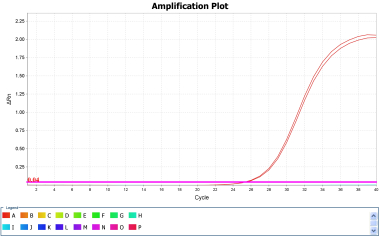|
ORF cDNA clones
|
CRISPR / TALEN
|
Lentivirus
|
AAV
|
TALE-TF
|
ORF knockin clones
|
|
Antibody
|
Proteins
|
miRNA target clones
|
qPCR primers
|
shRNA clones
|
miRNA products
|
Promoter clones
|
Validated All-in-One™ qPCR Primer for CD27(NM_001242.4) Search again
By default, qPCR primer pairs are designed to measure the expression level of the splice variant (accession number) you selected for this gene WITHOUT consideration of other possible variants of this gene. If this gene has multiple variants, and you would like to measure the expression levels of one particular variant, multiple variants, or all variants, please contact us for a custom service project at inquiry@genecopoeia.com.
Validated result:
Summary
The protein encoded by this gene is a member of the TNF-receptor superfamily. This receptor is required for generation and long-term maintenance of T cell immunity. It binds to ligand CD70, and plays a key role in regulating B-cell activation and immunoglobulin synthesis. This receptor transduces signals that lead to the activation of NF-kappaB and MAPK8/JNK. Adaptor proteins TRAF2 and TRAF5 have been shown to mediate the signaling process of this receptor. CD27-binding protein (SIVA), a proapoptotic protein, can bind to this receptor and is thought to play an important role in the apoptosis induced by this receptor. [provided by RefSeq].
Gene References into function
- Functionally differentiated Vgamma9delta2+ T cells lack CD27 expression and are found in reduced numbers in immunocompromised hosts (such as healthy newborns and HIV-infected adults) and during active pulmonary tuberculosis.
- Increased levels of soluble CD27 in the cerebrospinal fluid are not diagnostic for leptomeningeal involvement by lymphoid malignancies.The positive predictive value of sCD27 determination for LI was only 54%, but the negative predictive value was 92%.
- intragraft gene expression is a risk factor for acute cardiac allograft rejection
- IL-10 enhances B-cell IgE synthesis by promoting differentiation into plasma cells, a process that is inhibited by CD27/CD70 interaction
- CD27 and CD40 co-stimulatory signals regulated the p53-amplified apoptotic pathway in B cells through the inhibition of p53-independent apoptotic pathway primarily induced by BCR ligation
- CD27(-) effector CD8(+) T cells might be required for adequate control of chronic viral infection and prevention of disease development.
- CD148 and CD27 are expressed in a wide range of B cell non-Hodgkin's lymphomas and do not serve to distinguish between neoplastic cells of naive and memory B cell derivation
- In indolent lymphomas, sCD27 proved to be a powerful marker to predict progression-free survival (p = 0.008).
- Systesmic lupus erythmatosus flares may relate to the retention of CD27+ memory B cells. (revieew)
- Signals through CD70 in B lymphocytes of CD70 transgenic mice result in enhanced cell cycle entry while preventing differentiation into IgG-secreting plasma cells.
- In primary biliary cirrhosis CpG led to a markedly high frequency of intracellular IgM-positive B cells, associated with high levels of synthesized IgM and identified to be a function of CD27(+) memory B cells.
- functional and lineage relationships of three distinct memory CD4 subpopulations distinguished by their expression of the cysteine chemokine receptor CCR7 and the TNFR family member CD27
- Interaction of CD70 with CD27 plays a direct role in T cell activation mediated by IL-2.
- In systemic lupus erythematosus (SLE) patients, significant increases of CCR7-, CD27- and CCR7-, CD27+ and a reduction of CCR7+, CD27+ CD4 memory T cells were found.
- The memory B cell reservoir extends beyond the CD27+ compartment because B cells expressing surface IgG, but not CD27, have been found in human blood and provide further insights into B cell disorders of unknown etiology.
- In systemic lupus erythematosus, an increased frequency of CD27-negative memory cells is significantly associated with higher disease activity index and disease-specific autoantibodies.
- CD27-CD70 interactions may promote Th1 cell formation by permitting naive T cells to respond to differentiation signals and by promoting survival of activated effector T cells.
- Failure to increase surface expression of costimulatory molecules CD27 and CD28 following stimulation may contribute to naive T cell impairment in HIV infection.
- marginal zone-like IgM(+)CD27(+) B cells are clonally expanded in certain subjects with mixed cryoglobulinemia (MC) offers insight into mechanisms of HCV-associated MC and B-cell malignancy
- Expression defines phenotypic stages in B cell precursor development.
- A functional role for sCD27 in WM(Waldenstrom macroglobulinemia) pathogenesis, along with its utility as a surrogate marker of disease and a target in the treatment of WM.
- Lack of CD27 expression on natural killer (NK) cells is associated with high cytolytic function and, in combination with CD56, allows a better definition of cytotoxic effector cells.
- a homogeneous subset of CD27-,IgD-,CD95+ memory B cells with an activated phenotype was identified in lupus patients
- CD70/CD27 interaction provides a critical stimulus for expanding effector T cells, enhancing their cytotoxic activity and improving the antileukemic effector response.


